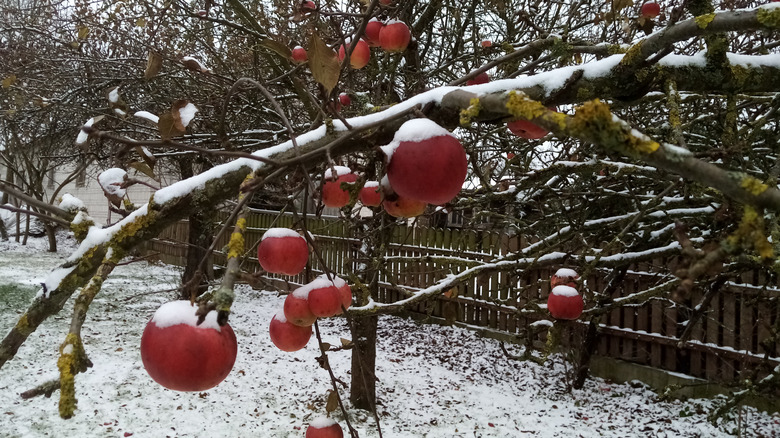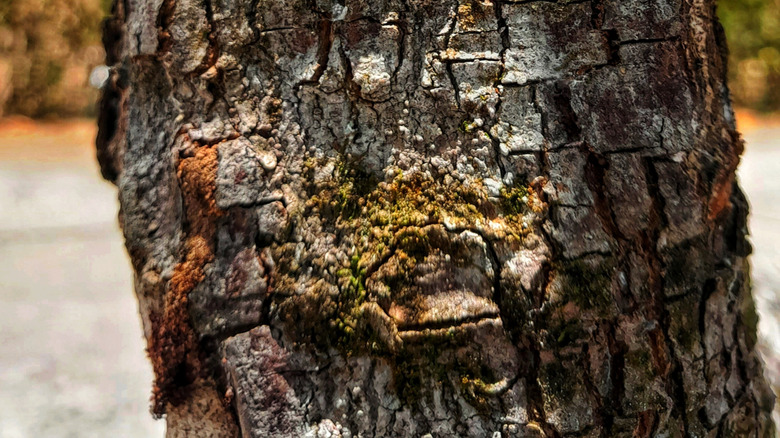The Handy Material That Can Keep A Fruit Tree Protected From Freezing Winter Temps
Having a fruit tree in your yard is the gift that keeps on giving. Every year, you can enjoy its edible bounty — it always seems to taste a little bit sweeter than grocery store produce. Growing fruit trees doesn't require specific gardening expertise, either. There are plenty of fruit trees that even a beginning gardener can grow in their yard. However, helping your fruit tree survive cold, wet winter weather is crucial if you want to continue plucking produce from it. Fortunately, wrapping a fruit tree with affordable, readily available burlap can help protect it from freezing temperatures and related issues.
Burlap is an excellent wrap for fruit trees because it is a natural woven fabric. The space between the fibers allows air to easily pass through while providing moderate, though importantly not total, moisture-resistance. It can also help insulate the tree when temperatures drop, and its durability means you can use the same burlap for up to two winters. If you prefer to use sustainable gardening products and materials, burlap is made from renewable resources, is biodegradable, and is compostable, making it an eco-friendly choice for protecting your fruit trees from wild winter weather.
Wrapping trees with burlap can prevent frost cracks and sun scald
If you want to help your fruit trees grow and produce faster, protecting them against potentially damaging winter weather with burlap wrap is vital. The freezing temperatures and even the winter sun work together to injure your trees. Frost cracks are among the easiest types of winter damage to spot. The tree trunk and branches develop vertical openings in the wood, the result of rapid temperature changes between day and night. As the tree's bark cools and its interior stays warm, the bark contracts, and cracks form. Frost cracks don't generally cause fruit trees to die. However, the openings may make it easier for diseases to infect the tree.
Sun scald is another serious issue that can affect fruit trees in winter, and it is also caused by extreme temperature changes. Sun scald occurs when the tree's bark is warmed by sunlight during the day, prompting cells to exit dormancy. At night, when the temperatures drop again, the awoken cells refreeze and die. The trunk develops jagged cracks through which insects and disease can enter. Apple, cherry, and peach trees are most susceptible to sun scald. Burlap is typically light brown or tan, so wrapping it around your fruit tree trunks helps to reflect sunlight. This prevents the bark from getting too warm, reducing the chance of extreme temperature changes.
Wrap fruit trees with burlap in fall to ready them for winter
One of the mistakes everyone makes when growing fruit trees is failing to prepare them for harsh winter weather. To help prevent frost cracks and sun scald, wrap your trees with burlap in the fall. The best time in fall varies by growing zone, but before the first frost is safest, which typically means sometime in November. Leaving your tree wrapped in burlap too long can also cause damage or infestation, though, so it's important to remove it in the spring. Once you've experienced the last frost for the season, usually sometime in April, unwrap your tree.
To protect your tree from freezing winter temperatures using burlap, start wrapping at the bottom of the trunk. As you wind the fabric around the tree, angle it upwards slightly, overlapping the layers by about one-third. Wrap the burlap around the trunk so that it's securely attached but not tight. The trunk needs good airflow to stay healthy. Continue wrapping the trunk until you reach the lower branches of the tree canopy, and then secure the burlap with garden twine or cable ties at the top, middle, and bottom of the trunk. Again, be careful not to tie the burlap too tightly or you risk damaging the bark.


